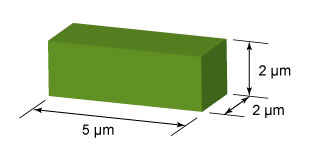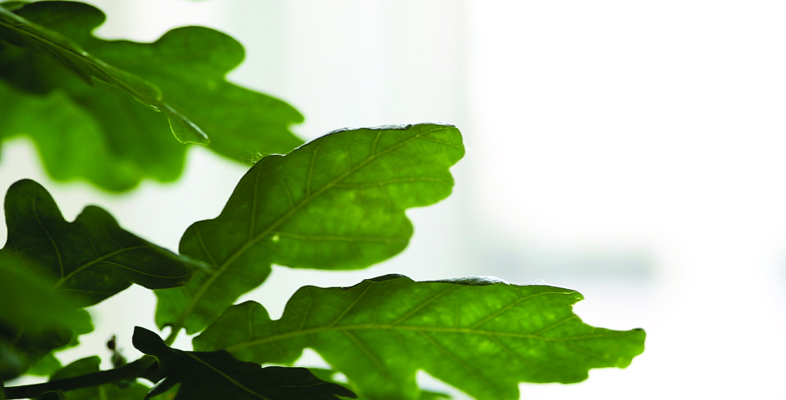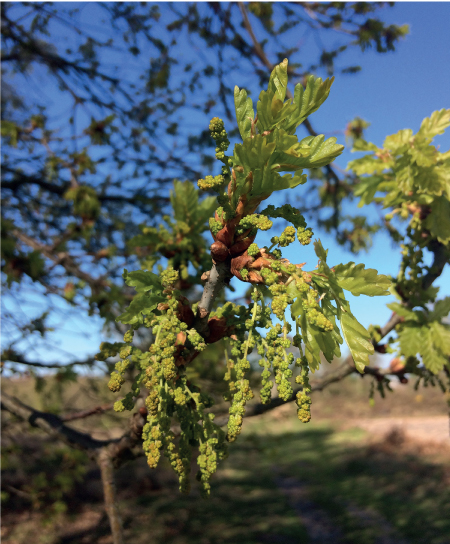2.9 Chloroplasts
The following slide show describes chloroplasts as organelles, or specialised components of cells. It explores the role of chloroplasts in photosynthesis, particularly the infrastructure they have to facilitate chemical reactions.
While working through the slides, record the following information to use in the questions that follow:
- the length of an oak chloroplast
- the amount of time it takes for a chloroplast to divide into two
- the thickness of a thylakoid membrane
- the rate at which ATP synthase makes ATP molecules.
Question 1
Length measures one dimension of an object. Chloroplasts and the cells that contain them are three dimensional, and therefore have a volume. Calculating volumes of irregularly shaped objects is difficult, so for simplicity you will consider a chloroplast to be a rectangular prism as shown in Figure 9.

Question 2
The volume of a rectangular prism is determined by length × width × height, and the volume of the block in Figure 9 is consistent with chloroplast volumes in the scientific literature. What is the volume of the stylised chloroplast shown here?
Question 3
What is the minimum volume that a cell would need to be to contain 100 chloroplasts within it?
Answer
The minimum volume the cell would need to be is 100 × 20 µm3 = 2000 µm3.
Question 4
Which of the following cell dimensions describe a cell of 2000 µm3?
Question 5
Use your notes from the slide show to calculate how long in seconds it takes a chloroplast to divide. Select the correct option from the list below to complete your answer.
Question 6
The chlorophyll molecules in the folded membranes inside chloroplasts absorb some wavelengths of light to power photosynthesis. However, they reflect light in the green part of the visible spectrum, which is why they appear green. You can therefore discern where there are chloroplasts in a plant, even though they are microscopic. There are so many that most people can see their colour pretty easily! Examine Figure 10 and consider which organs are green.
If you have the inclination you could investigate some real plants, either house plants or outside (on thin branches or smooth tree trunks, try scratching a small area of the surface gently with the edge of a ruler). Make some notes in the box below, particularly commenting on in which organs you observe chloroplasts to occur.
Answer
Chloroplasts are not just restricted to leaves. They are also found in the thin stems of woody species and in some plants, such as the oak pictured, the flowers and their stems contain chloroplasts.
If you were able to look further afield, you may have found that there are chloroplasts in the stems of herbaceous species and in some trees and shrubs, there are chloroplasts in the cells just under the bark which are visible when you scratch the surface.
Question 7
ATP, short for adenosine triphosphate, is a key molecule used by living organisms to drive the processes of life. From your notes, use the rate at which the protein ATP synthase makes ATP molecules to calculate the time it takes for one ATP molecule to be synthesised. Use the drop-down boxes below to give your answer in seconds, using an appropriate unit prefix.
Question 8
In light of the thickness of a thylakoid membrane (which you noted from the slide show) and your answer from the calculation above, add the bar ‘ATP synthase reaction across a membrane’ to the size–time explorer [Tip: hold Ctrl and click a link to open it in a new tab. (Hide tip)] .
Summary
Chloroplasts – organelles within a plant cell – are where photosynthesis occurs. They provide conditions that facilitate the reactions involved. In this level, you learned that microscopic proteins in the membranes inside chloroplasts are so abundant that you can discern their presence by the green colour you see when you look at most vegetation!
Next: Now look at the components of a leaf at even smaller scales by examining a glucose molecule, which you can do with the ‘Next >’ button, or you can return to the size–time explorer to choose a level for yourself.

